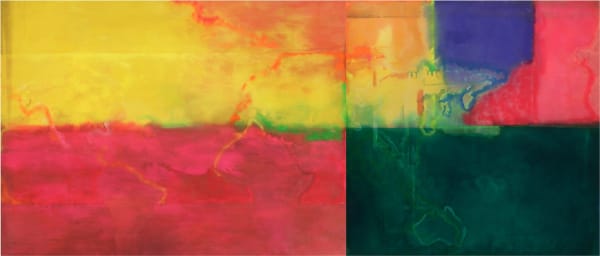Art Basel Miami Beach | Meridians: Meridians: Frank Bowling
Hales is delighted to announce its return to Art Basel Miami Beach 2019 for the inaugural year of the Meridians sector, with a historically significant painting by revered artist Frank Bowling OBE RA (b.1934, Guyana). Africa to Australia (1971) is a key work from the artist’s series of ‘map paintings’ – which are an important contribution to the canon of abstraction. Exemplary of Bowling’s paintings from this historic period, the artist combines vast fields of colour with figurative stencilled map elements, orchestrating the emotive potential of paint to communicate a visual experience of uniquely sensuous immediacy.
Frank Bowling (b. Guyana, 1934) moved to London in 1953, where his artistic career began shortly after his arrival at the Royal College of Art (1959-62). Bowling began as a figurative painter, incorporating personal and political subject matter in his work, before moving to New York in 1966, where he made a decisive turn towards abstraction. In this career-defining moment, he developed a process-based practice, exploring the nature and possibilities of paint.
After he moved to New York, Bowling became actively involved in the civil rights movement and the Black Emergency Cultural Coalition.[1] The artist was part of a milieu which included Jack Whitten, Melvin Edwards and Dan Johnson, as well as both Jasper Johns and Larry Rivers, who used maps as signifiers in their paintings. It was Rivers who initially helped Bowling use an epidiascope to project stencils of the maps onto canvas. Bowling states, ‘maps are immediately recognizable; like flags or targets, they are common visual property, being as Johns remarked, “things that the mind already knows.”’[2] Bowling’s use of the map would come to take on a variety of meanings – emblematic of personal and collective memories. By including maps, he explores an abstraction that intersects with cultural experience and historical subject matter. In an extensive essay on Bowling in the catalogue for ‘Mappa Mundi,’ curator and art historian, Okwui Enwezor suggests that what Bowling sought to accomplish in the ‘map paintings’ series was ‘the visual fusion of epic time and boundless space.’[3]
Africa to Australia (1971) began as a single canvas but Bowling soon decided to enlarge the surface of the painting by adding a second section to transform the work into a diptych. Although the two parts are separated visually through bold sections of colour, and physically through distinct disconnected canvases, the work is unified by the outline of continents of the southern hemisphere – South America, Australia and Africa.
Bowling painted Africa to Australia in 1971, which was a critical year in which he wrote the seminal article, It’s Not Enough to Say ‘Black is Beautiful’ in ARTnews and had a solo exhibition at Whitney Museum of American Art – firmly establishing his practice in the US. Africa to Australia was one of six monumental ‘map paintings’ featured in the exhibition, which to this day is one of his most acclaimed exhibitions and holds much scholarly interest.
In 2019, in addition to his ground-breaking retrospective at Tate Britain, Bowling’s works have been exhibited at revered institutions such as The Menil Collection, TX, The Whitney Museum of American Art, NY; The Met Museum, NY; The Minneapolis Museum of Art, MN; The Broad Museum, LA, CA; and The Royal Academy, UK.
Bowling’s paintings have been exhibited widely and internationally. Selected solo shows include Whitney Museum of American Art, NY (1971); Serpentine Gallery, UK (1986); Royal Academy of Arts, UK (2011); Spritmuseum, Sweden (2014-15); Dallas Museum of Art, TX (2015). In 2017 the Haus der Kunst in Munich presented Frank Bowling: Mappa Mundi, a comprehensive survey of large-scale paintings curated by Okwui Enwezor, which toured to Irish Museum of Modern Art, Dublin, Ireland, and Sharjah Art Foundation, UAE. Bowling's work can be found in numerous public and private collections including the Metropolitan Museum of Art, NY; Museum of Modern Art, NY; Museum of Fine Arts, MA; Dallas Museum of Art, TX; Royal Academy of Arts, UK; Tate, UK; Victoria & Albert Museum, UK and the Whitney Museum of American Art.
[1] Black Emergency Cultural Coalition was created by a group of artists in 1969, in response to Metropolitan Museum of Art’s exhibition, Harlem on my Mind which had omitted contributions of African American artists in the Harlem community. The group continued to protest for greater representation in major art museums in New York City.
[2] Frank Bowling OBE RA. The Map Paintings 1967-1971, London: Hales Gallery, 2013 p.6
[3] Enwezor, O. Mappa Mundi, New York: Prestel Publishing, 2017 p.40


